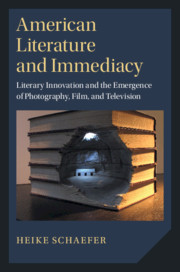 American Literature and Immediacy
American Literature and Immediacy from Part II - Literary Immediacy and the Cinema
Published online by Cambridge University Press: 19 December 2019
The chapter’s first part describes the interrelated but also contrary development of literature and film in the early twentieth century. It places modernist experiments with literary form in relation to the new representational and narrative strategies of early film. The second part explains in depth which new forms of immediacy the movies offered and how important these immediacy effects were for the cultural impact and popularity of early film, especially the “cinema of attractions.” The chapter also discusses the popular perception of film as a particularly modern medium. It argues that the oscillation between self-reflexivity and immediacy was central to the cultural work performed by early cinema because it allowed early film to train viewers in new forms of attention required by the accelerated pace, fragmentation, and informational density of modern life, while also providing compensatory relief and entertainment. Provoking media awareness as well as experiences of immersion, the early cinema reminded its viewers that their perception of the world was mediated, while the thrill of its immediacy effects offered them moments of respite from such self-reflexive considerations.
To save this book to your Kindle, first ensure [email protected] is added to your Approved Personal Document E-mail List under your Personal Document Settings on the Manage Your Content and Devices page of your Amazon account. Then enter the ‘name’ part of your Kindle email address below. Find out more about saving to your Kindle.
Note you can select to save to either the @free.kindle.com or @kindle.com variations. ‘@free.kindle.com’ emails are free but can only be saved to your device when it is connected to wi-fi. ‘@kindle.com’ emails can be delivered even when you are not connected to wi-fi, but note that service fees apply.
Find out more about the Kindle Personal Document Service.
To save content items to your account, please confirm that you agree to abide by our usage policies. If this is the first time you use this feature, you will be asked to authorise Cambridge Core to connect with your account. Find out more about saving content to Dropbox.
To save content items to your account, please confirm that you agree to abide by our usage policies. If this is the first time you use this feature, you will be asked to authorise Cambridge Core to connect with your account. Find out more about saving content to Google Drive.